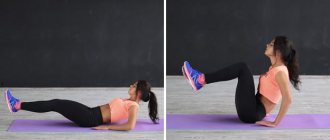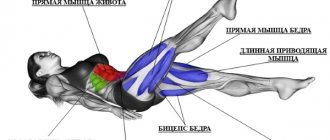About the “pendulum” exercise
It will help keep your side abdominal muscles in shape. This article provides a detailed description of this exercise. Here, especially for you who are interested in physical exercises, answers to all questions about this exercise are collected. The technique and characteristics of the “pendulum” are described. After reading the article and looking at the execution techniques, it becomes clear why the exercise is called that way.
It is not enough to dream of a beautiful, steel press; you need to make some efforts for this. Abs are the result of pumping the abdominal muscles, or simply put, the abdominal muscles. Most sets of exercises focus on the transverse and rectus muscles. With the help of the “pendulum” exercise, you can focus on training the lateral abdominal muscles, since the exercise pumps them deeply. The exercise also puts stress on the hips. To perform this exercise, your legs and back are additionally strained.
The question arises, is this exercise suitable for women or men, children or the elderly? All this is written below. This exercise is most suitable for bodybuilders and powerlifters because it creates a very strong muscle shell, which helps stabilize the torso when lifting a load of any weight.
But because the abdominal muscles are hypertrophied, the figure acquires a powerful, solid, monumental figure. That is why girls are strongly advised not to abuse this exercise.
A separate practice involves managing human biomechanics and focuses on individual, specific muscles. The “pendulum” exercise is usually performed at the end or at the beginning of a workout. The fact that the exercise is done in a lying position is very important, due to which it does not put pressure on the spine. So, let’s proceed to the technique.
Is the method of pumping up the abs using pull-ups on a bar effective?
Sculpted abs are the dream of both men and women, both bodybuilders and fitness enthusiasts.
Whether you're an athlete or just want to get your body ready for beach season, working on your abdominal muscles is definitely something you should do. And in order not to do planks, push-ups and crunches inside four walls, go outside and find a horizontal bar, because training in the fresh air is good not only for your health, but also for your mood. However, we warn you right away - it won’t be easy, but the result is worth the effort. By the way, an important advantage of swinging the press on a horizontal bar over the same plank or push-ups is that the result on this apparatus is achieved faster and can be visible after just a few exercises. The specificity of the horizontal bar requires the athlete to make a lot of effort to lift and hold the entire body above the ground, but thanks to this, the body acts as an excellent weight, which increases the effectiveness of the exercise and affects almost all muscles.
During exercises on the horizontal bar, the following muscles are included in the work:
- rectus abdominis muscle;
- trapezius muscles;
- deltoid muscles;
- triceps brachii;
- pectoralis major muscles;
- oblique and transverse abdominal muscles;
- back muscles;
- anterior thigh muscle group;
- muscles of the back of the thigh;
- small and medium gluteal muscles.
m
Execution technique
First you need to lie on the floor. You need to place your hands along the body, along the shoulder line. Next you need to raise your legs up, with your feet towards the ceiling. In this case, the stomach should be pulled in. Gradually, slowly, you need to lower your feet to the floor, to the left, then to the right, then to the left again, and further. The legs should be straightened. When performing this exercise, the head, legs and shoulders do not move and are in a calm state.
It can be difficult for beginners at the beginning, so for the first time it is allowed to keep your knees slightly bent. There are also many different variations and modifications of this exercise. Each of them has its own characteristics.
Option for girls: inverted pendulum
Active execution of the pendulum with legs is perfect for both beginners and advanced athletes. This version of the exercise improves blood circulation and tightens the waist through rapid movements of the limbs. To start performing this exercise, you need to lean forward, place your hands on the floor and spread your legs as wide as possible, slightly bent at the knees. Then one of the limbs moves to the side and with a sharp movement returns to its place, to the supporting leg, after which the supporting leg moves away and repeats the actions of the previous limb. Then a certain number of the same manipulations are carried out. How many times the athlete should repeat this action depends on his experience.
There are separate recommendations for each category:
- the normal number of repetitions for beginners is thirty times;
- for intermediate-level athletes, the norm is forty executions;
- for experienced ones - fifty.
"Pendulum" - educational materials
The moment you don't need anything, you are free.
The rest of the time you are a slave to some bullshit. (Tetcorax)
If you look closely—in general, the theme of “Pendulum” is completely undiscovered on the Internet—there is something mysterious, but what it looks like and, most importantly, how to make it is completely unclear. In principle, as I understand it, the whole “swing of the pendulum” consists of alternating “tilts of the body” relative to the vertical axis of the body - in different directions. (That’s why it’s called “pendulum”, and it’s obvious that only the upper part can be swung from a standing position torso - “pendulum movements”)
And again, it’s clear that it’s hardly possible to come up with something unusual. (If it is so well-known - but no one has really been able to come up with something practical - it is still a fiction that simply should not be diverted to.)
Moreover, on the Internet it is almost impossible to find any intelligible materials on this very “swing of the pendulum” and why this “swing” is actually needed - simple and accessible.
Everything that is on the Internet is about “swinging the pendulum” - and all materials on “swinging the pendulum” can be divided into at least the following three independent areas:
- “Pendulum swing” for pistol shooting (or “Shooting pendulum” or “Macedonian shooting” - with two hands.
- "Pendulum swing" in original hand-to-hand combat systems
- “Swinging the pendulum” in boxing and combat sports.
“Swinging of the pendulum” when shooting - it is possible that Bogomolov in his book, by “swinging the pendulum” or shooting “Macedonian”, meant pendulum movements of the body with alternate pointing of each pistol to the center line along which shooting is carried out.
But here’s what you can find on the Internet using the “arrow pendulum”
Just transitions from one position to another - with a shot. Obviously not shooting “Macedonian style” - nothing special and accessible to everyone.
Another “pendulum” with shooting - quite funny - but in my opinion for active and very brave guys.
Also training in operational shooting - also quite funny - well, it happens like this - you haven’t warmed up or your clothes are uncomfortable and suddenly you couldn’t roll over and got stuck in that position. And there we put two fascists with machine guns - they stand there laughing.
Leaving the line of attack using a “pendulum” - I don’t know, it’s quite slow and it’s unclear where to use these leaving the line of attack - maybe in a duel. (It is clear that if such departures were at all effective, everyone would know about it and constantly develop it. But it’s quite risky to try to leave the line of fire. In general, a step is very slow and inconvenient - you need to think to do it.)
Also a “ pendulum” - but of course it tumbles in such a way that the “fascist” has to turn around and shoot when the one tumbling rises. (Well, in fact, it’s obvious - it’s better not to tumble against a person with a firearm - he will immediately misunderstand it)
Protection with a “pendulum” from firing from the Shpagin Submachine Gun Pistol is also debatable - the PPSh’s firing rate is 1000 rounds per minute - it will simply cut into pieces - tumble, don’t tumble.
"Pendulum swing" in hand-to-hand combat - various attempts to adapt the "pendulum movement of the body" for use in hand-to-hand combat. The following methods of “swinging the pendulum” can be distinguished:
“Pendulum” by Oleg Maltsev - but in reality - deviations from a natural position.
"Pendulum" by Putilin
A short video about the use of “pendulum movements” in hand-to-hand combat.
Two-hour seminar by Sergei Putilin about “swinging the pendulum”
Another seminar on the “pendulum” by Sergei Putilin - called “basic exercises” - you can see the technique is identical to the technique of Sergei Putilin.
Also Sergei Putilin - about the “pendulum” based on the “Cossack dance”
“Pendulum” by Valery Kryuchkov ( JSC “Strela” ) - in fact, the most practical use of “pendulum movements of the body” - that is, it is specifically about the use of “pendulum movements of the body” in hand-to-hand combat - using the inertia of the previous movement to increase the speed and power characteristics of the next movement .
“Pendulum with a knife” - and there is even one - alternating movements of the body back and forth. In principle, a rather interesting movement technique.
“Pendulum of the military tradition of the Russian style” - again reciprocating (“pendulum movements”) with the body - back and forth.
“Pendulum” by Sergei Lavrov - a whole seminar “Pendulum and its types” lasting half an hour. (
And also Sergei Lavrov - about the “pendulum”
“Pendulum movements” in boxing and combat sports - everything is actually serious here - the price of the experiment is knockout. Therefore, in my opinion, this is the most practical, and most importantly proven method of “swinging the pendulum” - you can say like this, this is the real “pendulum” - which can be used in hand-to-hand combat.
Tyson pendulum - what is important is real effectiveness in combat conditions.
An MMA master class from Russian mixed martial arts fighter Alexander Shlemenko about the “pendulum” is also quite interesting. At least it’s clear what we’re talking about and this, for example, is quite enough for me.
Pendulum in boxing from Alexander Kolesnikov - so to speak, classic boxing “pendulum movements of the body” and their use in attacking and defensive actions.
That’s all about the “pendulum” that can be found in the Russian segment of the Internet. Quite a bit in my opinion. (It’s interesting that the “pendulum” is a purely Russian invention - based on Vladimir Bogomolov’s book “The Moment of Truth” - or are there similar developments abroad - it’s clear that there are “pendulum movements” in boxing. But these are the ones for shooting, their hand-to-hand combat - some mysterious techniques. There probably are, it’s just not clear what they might be called. Well, maybe someday they’ll come across it - it would be interesting to compare)
Modification for men
This option is designed to develop endurance and strength. Doing this exercise is similar to imitating the movements of a pendulum. Thanks to these exercises, you can burn a lot of calories and pump up the muscles of the whole body.
In gyms and fitness centers there is a special exercise machine for this. At home it looks a little different. You need to take the bar, secure one end of it, and take the other end in both hands in front of you. The left leg moves forward, the right leg takes a step back. The heel should be raised, resting your toes on the floor. With one quick movement of outstretched arms, the bar is thrown to the other side. At the same time, you need to expand the body. While remaining in the original position.
Movements are made quickly and without delay. As the pendulum approaches your hip, you can slow down slightly. The weight of the bar and the number of repetitions will increase gradually as the muscles get used to it. Also include various weighted twists for variety.
Exercises of the “Main” complex
| “Palms” Stand up straight and straight. Arms bent at the elbows, elbows down. Place your hands at shoulder level with your palms facing the viewer. Inhale synchronously with clenching your palms into fists. Do 12 times for 8 breaths. |
| “Shoulder straps” Hands are sharply, almost in a push, directed from the waist down. You should simultaneously take a short and noisy breath. After finishing the exercise, the arms return to their original position, taking a relaxed state in the waist area. The number of movements is 96, divided into 12 approaches. |
| “Pump” (inflating a tire) Stand straight and straight with your head down. Bend your back at the lumbar region. Lower your arms down, relax your hands. The back is relaxed. A smooth forward bend is made, and at the same time you need to take a short breath through your nose. The number of approaches is 12, 8 movements in each, a total of 96 active movements should be obtained. |
| “Cat” “Springy” squatting exercise, which is accompanied by turning the torso to the right and left sides alternately. At the same time, it is necessary to maintain the rhythm of breathing, synchronizing it with the movements of the body. Number of approaches – 12, 8 movements each. |
| “Hug your shoulders” Starting position: arms raised horizontally to shoulder level, slightly relaxed and bent at the elbows. At the moment of inhalation, you should sharply close your hands, as if hugging yourself by the shoulders. The norm for this movement is the same 12 approaches of 8 “hugs” each. |
| “Big Pendulum” When tilting your body, try to reach your fingertips towards your knees, while taking a sharp breath. After straightening, the lower back bends, the hands go to the shoulders (hug the shoulders). A total of 12 sets of 8 movements. |
| “Head turns” From the starting position at attention, head turns are made alternately to the right and left sides. The exercise is accompanied by inhalation. After returning the head to the initial position, the exhalation goes out imperceptibly through the nose or mouth. A total of 12 sets of 8 movements. |
| “Ears” The head moves alternately towards the shoulders, while it is important not to strain the neck muscles. The exercise should be accompanied by short breaths, the gaze should be directed strictly horizontally. The recommended norm is 96 movements, divided into 12 approaches. |
| “Pendulum with the head” The exercise is also performed from a stand at attention; the head should be raised and lowered, accompanied by active breaths. An important key to successfully performing this exercise is the correct breathing rhythm. Number of movements – 96. |
| “Rolls” with the right leg in front. The right and left legs are one step apart. One in front, one behind. The body weight moves to the leg in front, simultaneously with this a barely noticeable squat is made and at the same moment - inhale. After this, the weight of the body is transferred to the left leg standing behind. We squat down slightly on it and sharply sniff the air. Forward - back, inhale - inhale. Number of approaches – 12, 8 movements each. |
| “Rolls” with the left leg in front The exercise is performed in a similar way to the previous one, but this time the left leg plays the leading role. This element of therapeutic gymnastics is recommended to be performed immediately after “Rolls with the right leg”; the number of approaches remains the same. |
| “Forward step” Left or right bends simultaneously at the hip and knee joint. The body weight is concentrated on the second leg, and a light and smooth squat begins. As in previous exercises, the leading role is given to breathing technique, which should coincide with the rhythm of the movements. |
| “Back step” The body is aligned vertically, the right or left leg is bent at the knee as much as possible, the lower leg is retracted back. Maintaining the position of the body, a smooth squat is performed, which should be accompanied by inhalation. After each approach, the position of the legs is changed; a total of 12 approaches (8 squats each) should be performed. |
You will find a detailed description of breathing exercises by A.N. Strelnikova and recommendations for their implementation in the books of Dr. M.N. Shchetinin.
Now, having familiarized yourself with the technique of performing the exercises and reading the brief recommendations, turn on the video and start doing the exercises.
- "Main" complex. Video.
- Is it possible to master A.N. Strelnikova’s breathing exercises on her own?
- How to start mastering breathing exercises by A.N. Strelnikova
- How to inhale
- How much and when to do.
- Why is it still worth attending the classes of Dr. M.N. Shchetinin?
- "Auxiliary" or additional complex











